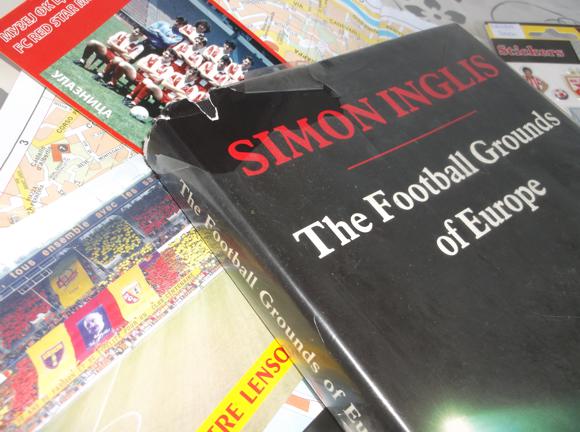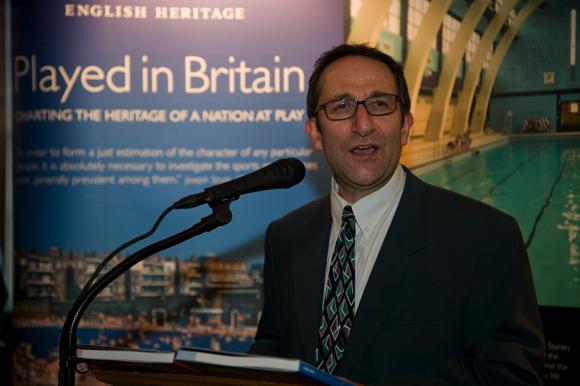On the eve of Italia ’90, writer and stadium historian Simon Inglis published the ‘Football Grounds of Europe’. Researched and recorded during a 51,000-mile trek either side of a still sturdy Berlin Wall, this seminal work is a historical document of the pre-boom era. It is also the only one of its kind, never republished or improved upon. On the eve of another World Cup, Peterjon Cresswell meets the author to look back at one of the finest books ever written on international football – and how it came to be written.
‘How could the 1990 World Cup fail to mesmerise us all?’ Thus Simon Inglis begins his 288-page masterpiece ‘The Football Grounds of Europe’, the glossy, painstakingly researched result of what he describes in the preface as a ‘Grand Tour’ of 51,000 miles, 150 stadiums and 33 countries.
How indeed?
Never updated, never re-issued and certainly never bettered, it was published on the eve of Italia ’90, ‘what I would like to think was brilliant timing’, as he now laughs. ‘I was simply following what I wanted to do.’
Yes, naturalmente, there was a World Cup to preview but what Inglis – a Birmingham-born graduate of modern history and history of architecture, responsible for the previous ‘Football Grounds of Britain’ – would not know was his timing coincided with more than the tournament of Pavarotti, Gazza and Baggio.
Before Italia ’90 was the Hillsborough disaster, the old First Division, a European Cup barely changed since 1956 and the Berlin Wall. European football was a big adventure and the domestic game was a dank, often dangerous, pursuit.
After Italia ’90 came all-seated family-friendly arenas, the Premiership and its TV Sundays, the Champions League and freedom of movement across most of Europe. In breve, the boom. Oh, and the Internet.
Inglis had no Internet on his Thatcher-era stadium odyssey. Six World Cups and a lifetime later, East Germany, Yugoslavia and the USSR no longer exist, nor many of the stadiums as he would have visited them, camera, tripod and all.
‘Photography was a whole different issue,’ Inglis recalls. ‘Though I took most of them, which I still have on slides somewhere in the loft, the ones I had to ask for were sent to me by post. I then had to have them duplicated at the publishers, and post them back.’
Travel itself was another world, literally. ‘To get into Albania, I had to pose as a schoolteacher,’ he remembers. ‘At that time, very few people went there. I had to stay for a week as part of an official tour, and soon realised that many of my fellow travellers were also posing as schoolteachers! I had to persuade the tour organisers that I was mad keen on football and simply had to see the stadium.’
Albania only warrants two pages in ‘The Football Grounds of Europe’ but it’s full of the kind of detail that characterises all further entries, from Austria through to Yugoslavia. A wide angle shot of a sternly Socialist sports ground – home to then dominant 17 Nëntori – and smaller photos of the Stalinist VIP podium and locals cycling by the entrance – complement a stadium saga in which the founder of Albanian Communism, King Zog, Mussolini’s troops and Italianate architecture all play a part. (If only Norman Wisdom had had a stand named after him.)
‘I discovered that football was an international gateway, the glue that binds nations,’ says Inglis. ‘I saw very few cars, just people on bicycles, and horses and carts. It was like stepping back into the early 20th century. They could only see football on fuzzy Italian TV broadcasts, they couldn’t buy a Beatles record, yet Albanians were so well informed about English football, our players and clubs.’
‘The strictest control was in East Germany where I was followed all the time,’ he remembers. East Berlin’s Stadion der Weltjugend (‘World Youth Stadium’) warranted only half a page (and no doubt a whole day’s surveillance) but is a perfect example of then and now. It was demolished in 1992 after Unification – to be the site of today’s foreign intelligence agency, Germany’s equivalent of MI6.
Leningrad, Moscow (‘I walked so much, 25 years later I now have to have a hip replacement – I like to think of it as an equivalent of an industrial injury!’), Izmir, Antibes, Eskilstuna, Ta’Qali on Malta, all were visited in his 18-month quest. ‘I remember looking up at the huge departures board at Heathrow Terminal 2. Every destination it was showing I had either just visited or still needed to visit. It was a daunting thought!’
As deadline – and Italia ’90 – approached, not only was the map of Europe changing but at home, as a stadium expert, Inglis was being invited onto committees looking into an overall restructure of British football in the wake of Hillsborough. The groundbreaking Taylor Report, and its recommendations for all-seater stadia, would be published shortly before ‘The Football Grounds of Europe’.
Inglis later wrote ‘Sightlines: A Stadium Odyssey’ and ‘Engineering Archie: Archibald Leitch’ and is now involved in Played in Britain, a series of books which chart and celebrate Britain’s sporting heritage. After focusing on the Olympics in Britain, lidos (‘Great Lengths’) and sports and pastimes in cities such as Liverpool, Manchester and Glasgow, ‘Played in London’ (‘from boathouses on the Thames to Wembley’) is published this September.
Just as his philosophy – ‘football was the easiest and quickest way to tap into the culture of any country’ – underscores the writer’s European stadium odyssey of 1988-89 – so an introduction to a book published in 1801 provides the framework for Played in Britain. In the words of Georgian-era engraver and antiquary Joseph Strutt, author of ‘The Sports and Pastimes of the People of England’: ‘In order to form a just estimation of the character of any particular people, it is absolutely necessary to investigate the sports and pastimes most generally prevalent among them’.
Looking back, Inglis acknowledges that the ‘The Football Grounds of Europe’ is now a historical document from an era when you could just wander at will into the San Siro. ‘Behold,’ he writes, ‘the steel and glass temple to the great God of calcio, where the World Cup will open and with it, a new chapter in the history of stadium design’.
‘The Football Grounds of Europe’, published by Willow Books, 1990. Out of print. Copies from $65, vgc $81, at www.amazon.com. ‘Played in London’ (360pp, £25) to be published by Played in Britain on September 1.





